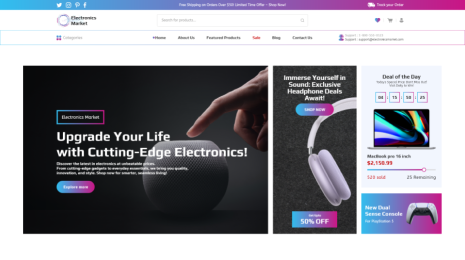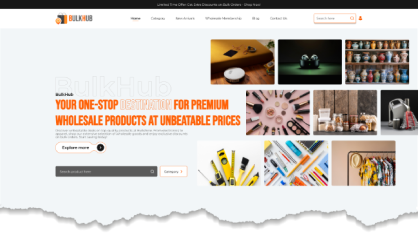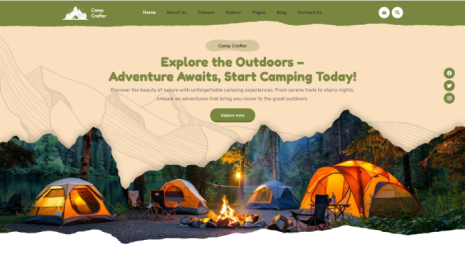
Creative professionals and freelancers need to display their work effectively and attractively. However, this is a challenge whether you are a photographer, writer, or blogger. If you wish to find new clients or create an impression on your employer, it is essential to have a portfolio website.
Creating a website for your profession allows you to build your online presence and have a space that your prospective can visit to review your best work. Additionally, having your website gives you control over what and how you want to display your art.
But as easy and exciting as it sounds, website building can be an overwhelming task to conquer, especially when you lack experience in web development. Therefore, you can employ WordPress to save time and not spend a lot on hiring a professional.
We have listed easy-to-follow steps to help you create a high-quality, attractive, budget-friendly portfolio website.
What Is a Portfolio Website?
Creative professionals, freelancers, and businesses must create a portfolio website in today's digital age. But what is a portfolio website?
If you have work that you would want others to view and appreciate, as well as hire you or buy your offerings, you can create a website for this purpose. These portfolio websites enable you to display your skills and help you stand out.
Developing a portfolio website enables your services to come into the sight of other users, prospective clients, and employers. By creating a good website for your portfolio, you can keep it active for a long time and share various case studies, projects, and other work details.
A great portfolio website is the best form of self-expression and is ideal for relaying your expertise and skills.
Step-By-Step Guide to Create the Portfolio Website
Building a simple and elegant online portfolio for your professional needs is easy and takes only a few steps. Using WordPress, you can use a domain name modified to your liking and establish a brand on your terms.
A portfolio website will allow you to display your work in the best light and create a desirable impact on others. Whether they are journalistic articles, interior designs, wedding photographs, or social campaigns, your efforts will get the best platform. You will be capable of attracting future clients, supporters, and customers.
This section will discuss some steps that help you create a compelling website for your portfolio.
Step 1: Selecting the Work to Highlight in the Portfolio
The first step to building a website is deciding what your online portfolio should include. When concerning your online website, it is impossible to encompass every little project on your portfolio. Hence, you must have enough information and projects not to overcrowd your website.
Displaying sufficient information will keep your website well-structured and help you choose your highest-quality projects. You can show your audience all the best works you are proud of.
You can rely on your close ones or learned peers to help pick your best pieces. Doing so will accurately tell the audience about your expertise and what you are best at.
To summarise, a terrific portfolio will give more weight to quality other than choosing all your work. Display only those projects that underline your artistry and skills, captivating the audience's attention and giving them a reason to work with you.
Step 2: Documents and Multimedia Need to Be of the Highest Quality
If you are a photographer, illustrator, or create any other visual media, you will likely want to display your work so your audience can appreciate every detail. Therefore, you must ensure that your documents and multimedia are visible on your site in superior quality.
In other words, you must add numerous high-quality media that efficiently represent your artistry and attracts your visitors' attention. However, if you only add multiple high-quality multimedia, they may hamper the loading speed of your website. Hence, why optimizing multimedia from website becomes a necessity.
This step is of utmost importance if you are building an online portfolio to showcase your photographs. Following this step will help improve your website's speed and allow the visitors to load and view your work in detail quickly. You can also use plugins to optimize media files if your portfolio contains more documents and files to optimize them for easy loading and viewing.
Step 3: Install WordPress and Choose the Host Provider
Now that you have an idea of what you will be publishing on your website and have already optimized your multimedia and files, it is time to choose an ideal host for your WordPress website and install WordPress.
There are a few things that you must look for to select an ideal host provider for your website. These include:
Good Past Performance: A good web host does not have to be perfect, but it is right to choose an option that has shown better performance formerly.
Committed Support Team: You must choose a host that readily offers a good team for support to help with any website issues.
Web Security: If there is one thing that you cannot disregard, it is the security a host offers for your website. Look for the best security features.
Ability To Expand: If you wish to keep a window open to new projects, you must look for a host that can manage a website requiring more effort.
Once you have chosen the best hosting, it is time to install WordPress. You can follow the following steps:
- Sign up with your provider
- Access your plan’s private cPanel
- If available, use a one-click WordPress installation. Or you can use the Softaculous option for installing the app.
- In “Softaculous Apps Installer," find WordPress > "Install Now."
- Fill in your WordPress website details (username, description, admin password, etc.), and replace the default name and password.
- Click “Install” to create your WordPress website.
Step 4: Choosing the Website Theme and Plugins
Choosing the best website theme and plugin is unlimited and indefinite, as it will significantly depend on your preference and what you find ideal. However, selecting the best out of the lot can be a struggle. Therefore, when choosing the best portfolio WordPress theme, you must consider the following points:
Simple: A busy theme can steal the attention that your content deserves. Hence, ensure that your chosen theme has a limited color scheme, simple layouts, no flashy animations, and few user-friendly widgets.
Responsive: With the maximum number of visitors being mobile users, it is essential to have an updated and responsive WordPress theme.
Browser Compatibility: Choose a theme that works efficiently with all browsers. Make sure to test the piece for various web browsers. It is advisable to purchase premium WordPress theme with all the necessary features for portfolio website.
Next, choosing good plugins is necessary for your website. Otherwise, an awful plugin can ruin your website and user experience. Therefore, when looking for plugins for WordPress, consider standard ratings, active installations of the plugins.
Step 5: Build the Header and Project Gallery
You can begin by creating your portfolio page by building its header and a project gallery. For the header, you can include a simple message with a CTA. To do so, you can:
- Visit Appearance and select customize.
- Add a title in the section that allows you to edit the big header.
- Adjust the text based on your needs.
- You can add images and add parallax effects.
- Next, creating a project gallery is critical for your site that showcases all your work. For this, you can:
- Visit the dashboard and select portfolio.
- Add a new section for the portfolio.
- Go to the content tab to add the main title.
- Under custom posts, add a featured image to each of your projects.
- Visit the setting tab to enable "open portfolio in a lightbox?" Allowing you to expand your portfolio for a new project quickly.
Step 6: Constructing the About and Contact Pages
The next step involves telling your audience about yourself and adding contact pages to allow them to reach out to you. To add an About page, you can follow the following steps:
- Go to Customizer > Our Focus section (or any other name depending on your theme)
- Under the header, replace the content with "About Me."
- You can add multiple widgets with the widgets option.
- Add title, text, and image to each device.
- A contact page lets clients and employers contact you efficiently and professionally. To add a contact form, you can do as follows:
- Customizer > Sections order > Contact Us
- Visit settings and add email ID.
- Edit the title using the main content.
- Go to the extensive title section > content > first button link and add #contact to create anchor text for lining the contact form to CTA.
Step 7: Upload and Finish Portfolio Website Creation
You can play around by adding more sections, projects, or individual pages. This helps you to improve the attractiveness of your website. After, you are satisfied with how your portfolio website looks and the work you have added, you can upload your WordPress portfolio website.
Conclusion
You must have an appealing portfolio website to leave an impression on your prospects or employers. Ensure that your website displays all your best qualities and skills. You can follow the above given steps to start making an impactful online portfolio.
FAQs on Portfolio Website
What Should Be Key Features of Portfolio Website?
A good portfolio consists of all the best features if you want to get more clients. To ensure this, you can follow the given list:
About Me: Your about me section should have an introduction, qualifications, and professional life history. In this section, what you are passionate about, your likes, and everything that positively highlights your work.
Professional Photo: Use a high-quality portrait photo that has your headshot and highlights your face. Make sure to smile genuinely to look inviting and trustworthy.
Work Samples: Most importantly, add work samples to showcase your skills by choosing one of your best projects.
What is Difference Between a Website, Blog, And Portfolio Website?
There is a stark difference between a website, a blog, and a portfolio site. A website tells your audience about you, your location, and your business. A blog shows how well you know about the latest trends and thoughts about your area of specialization.
Besides, a blog also shows how well-trusted you are in the industry. On the other hand, a portfolio will showcase all your best work to help your clients or employers know what you do best and what you have to offer.









